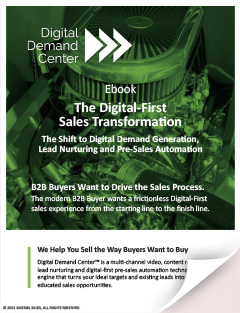
When to Use Account Based Marketing (ABM)
There are many strategies to help focus B2B marketing efforts. Among the most effective is Account-Based Marketing (ABM), a strategic marketing approach that focuses on targeting and engaging specific individual accounts or companies. ABM narrows your marketing focus towards a segmented, hand-selected group of customers that fit your Ideal Customer Profile (ICP) rather than casting a wide net to a broader audience. It takes the concept of marketing towards your ideal customer and narrows the focus even further. Learning how and when to use account based marketing tactics can improve your sales funnel production.
The goal of ABM is to create highly personalized and targeted marketing campaigns that cater to the specific needs and preferences of key accounts or high-value customers. In traditional marketing, businesses often develop generic messages and content to reach a wide audience, hoping to attract potential customers among the masses. However, ABM flips this approach and customizes marketing efforts for individual accounts or a select group of high-priority accounts.
The ABM strategy involves the following key steps:
- Identify target accounts: The first step in ABM is to identify and select the high-value accounts that align with the company’s ideal customer profile. These accounts are typically those with significant revenue potential or strategic importance.
- Gather insights and research: Once the target accounts are identified, detailed research is conducted to understand the account’s specific needs, pain points, organizational structure, decision-making processes, and key stakeholders.
- Personalize marketing messages: ABM involves creating tailored and personalized marketing messages, content, and offers for each target account. The content is designed to resonate with the account’s specific challenges and goals, showcasing how the company’s products or services can address their unique needs.
- Select marketing channels: ABM uses a mix of marketing channels to reach the target accounts effectively. This could include email marketing, social media, direct mail, personalized website content, and one-to-one interactions such as phone calls or meetings.
- Engage key stakeholders: ABM focuses on engaging multiple stakeholders within the target account, as buying decisions in B2B scenarios often involve various decision-makers and influencers. The marketing efforts aim to build relationships with these stakeholders and align the company’s offerings with their individual interests.
- Measure and optimize: ABM campaigns are closely monitored and measured to assess their effectiveness. Metrics such as engagement rates, conversion rates, pipeline progression, and revenue generated from the targeted accounts are analyzed to optimize future ABM strategies.
ABM is particularly effective in B2B (business-to-business) marketing, where sales cycles are longer, and individual accounts hold significant value. And ABM works best when it represents a collaboration between all your customer-facing teams, including sales and customer support. They can provide valuable information about the needs and challenges of your target accounts. Once you have identified potential target accounts, engage in account profiling to deepen your understanding of each account. This involves researching the account’s business objectives, recent news or events, financial performance, and any other relevant information that can inform your ABM strategy. Engage in regular discussions with your sales team to get their input on target account selection and to ensure alignment on account-specific strategies.
By focusing efforts on a select group of accounts and delivering personalized experiences, ABM can lead to higher customer satisfaction, increased customer retention, and improved overall marketing ROI.
When Should You Use Account-Based Marketing?
ABM is a valuable strategy in specific scenarios where the company’s goals and customer engagement can benefit from a highly personalized and targeted approach.
Here are some situations when a company should use ABM:
- High-value or strategic accounts: ABM is particularly effective when dealing with high-value accounts or strategic customers. If your business relies on a small number of key accounts for a significant portion of its revenue, ABM can be an ideal approach to nurture and deepen relationships with these accounts.
- Long sales cycles: In B2B industries with long and complex sales cycles, ABM can be instrumental in engaging and nurturing key decision-makers within target accounts throughout the buying process. By providing personalized content and support, ABM can help accelerate the sales cycle and drive conversions.
- Multiple stakeholders: When the buying decision involves multiple stakeholders with different needs and interests, ABM can help align the messaging and content to address each stakeholder’s concerns effectively.
- Customizable offerings: Companies that offer customizable products or services can benefit from ABM since it allows them to showcase how their offerings can be tailored to meet the specific needs of individual accounts.
- Account expansion and up-selling: ABM can be used to up-sell or cross-sell to existing customers within an account. By understanding the account’s needs and providing tailored solutions, companies can strengthen their relationships and increase customer lifetime value.
- Penetrating new markets or industries: When a company aims to enter a new market or industry, ABM can be valuable for building relationships with key accounts in that sector. A personalized approach can demonstrate the company’s understanding of the industry’s unique challenges and position it as a trusted partner.
- Limited marketing resources: ABM is a focused strategy that requires resources, and it may not be feasible for every company to implement ABM across its entire customer base. Companies with limited marketing resources can use ABM to concentrate their efforts on high-priority accounts that offer the most significant potential for growth and revenue.
- High competition: In highly competitive industries where differentiation is crucial, ABM can help companies stand out by delivering unique and personalized experiences to target accounts.
Ultimately, the decision to use ABM should be based on a careful assessment of the company’s business objectives, target market characteristics, and the potential benefits of a more personalized marketing approach. By leveraging ABM strategically, companies can build stronger relationships with their most valuable customers and achieve better results in terms of customer acquisition, retention, and revenue growth.




